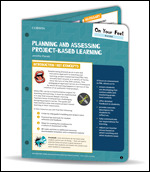On-Your-Feet Guide: Planning and Assessing Project-Based Learning
Series:
On-Your-Feet-Guides
On-Your-Feet-Guides
Other Titles in:
Teaching Methods & Learning Styles
Teaching Methods & Learning Styles
August 2020 | 6 pages | Corwin
While Project-Based Learning can be a transformative engine for teaching and learning, it must be implemented in a way that ensures deeper learning. Teachers know firsthand how challenging designing high-quality projects can be. This On-Your-Feet Guide walks teachers through practical steps for planning and assessing project-based learning experiences in their classrooms.
The On-Your-Feet Guide for Planning and Assessing PBL provides:
The On-Your-Feet Guide for Planning and Assessing PBL provides:
- A step-by-step guide to building your project rubric
- Practical tips and tools for student reflection and feedback
- Steps for creating the conditions for a culture of assessment in your PBL classroom
- QR codes and links to additional resources, downloadable templates, and a companion website
On-Your-Feet Guides (OYFGs) provide you with the ultimate “cheat sheet” to implement effective change in your classroom while in the moment of teaching. Designed for accessibility, and providing step-by-step guidance, the OYFGs are written by experts who take research-based practices and make them doable for the busy teacher.
Each On-Your-Feet Guide is laminated, 8.5”x11” tri-fold (6 pages), and 3-hole punched.
Use the On-Your-Feet Guides
- When you know the “what” but need help with the “how”
- As a quick reference to support a practice you learned in a PD workshop or book
- To learn how to implement foundational practices
- When you want to help your students learn a specific strategy, routine, or approach, but aren’t sure how to do it yourself
- When you know the “what” but need help with the “how”
- As a quick reference to support a practice you learned in a PD workshop or book
- To learn how to implement foundational practices
- When you want to help your students learn a specific strategy, routine, or approach, but aren’t sure how to do it yourself
